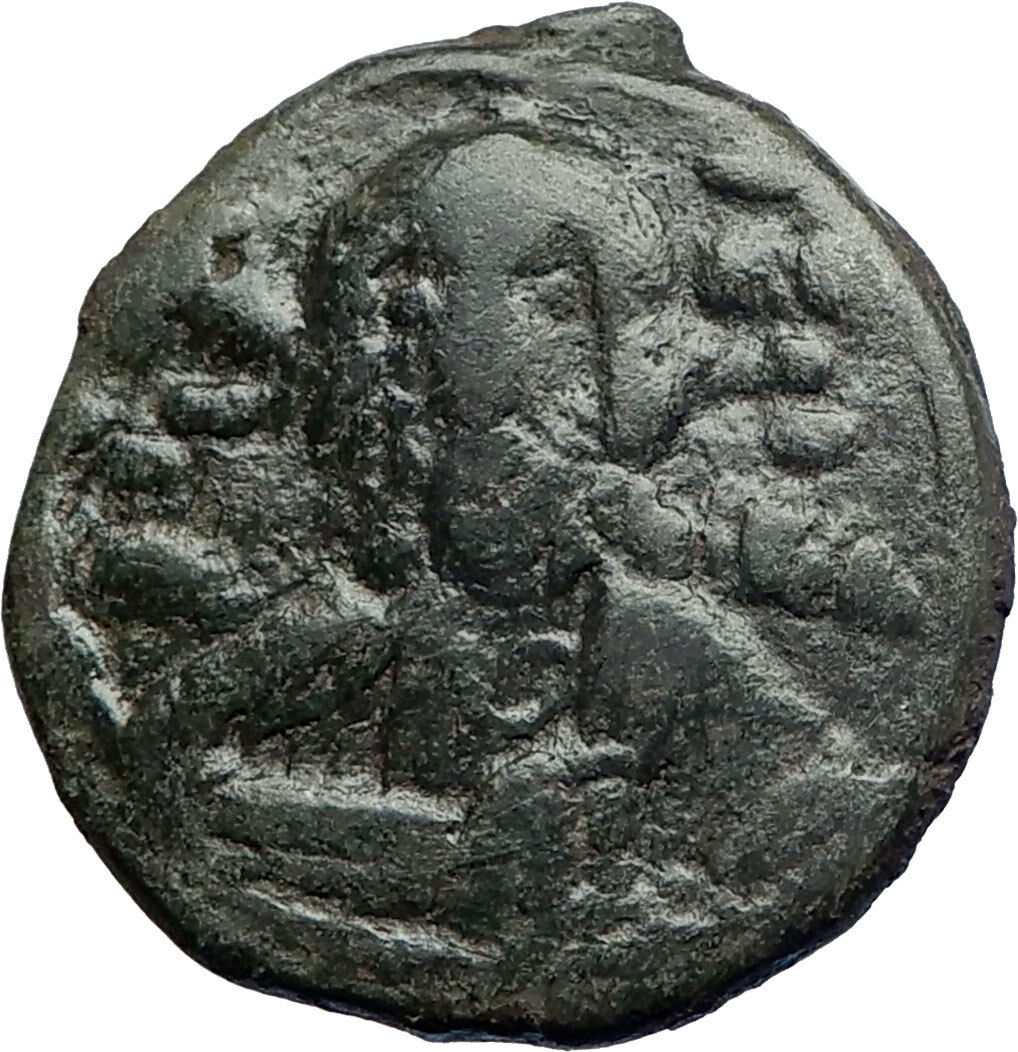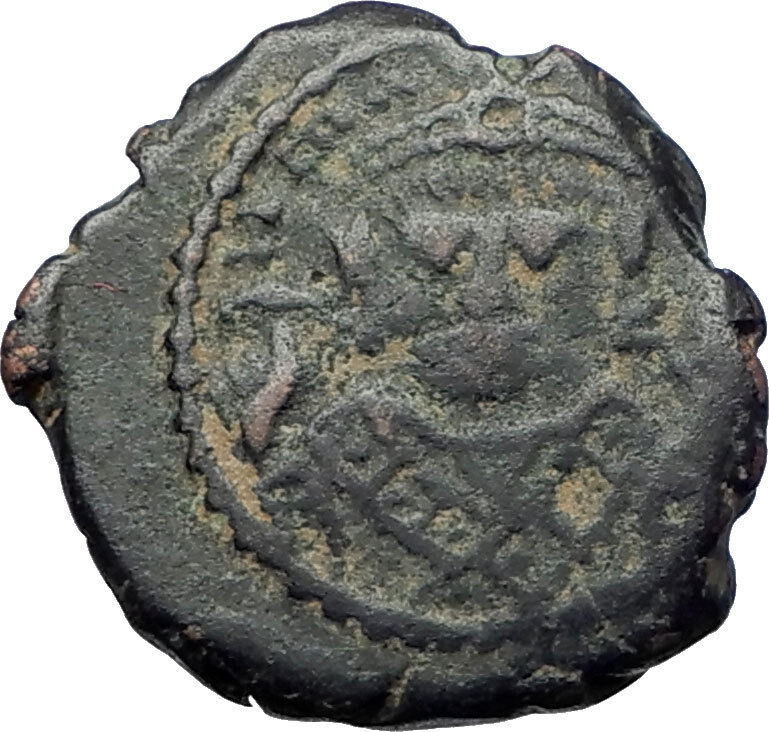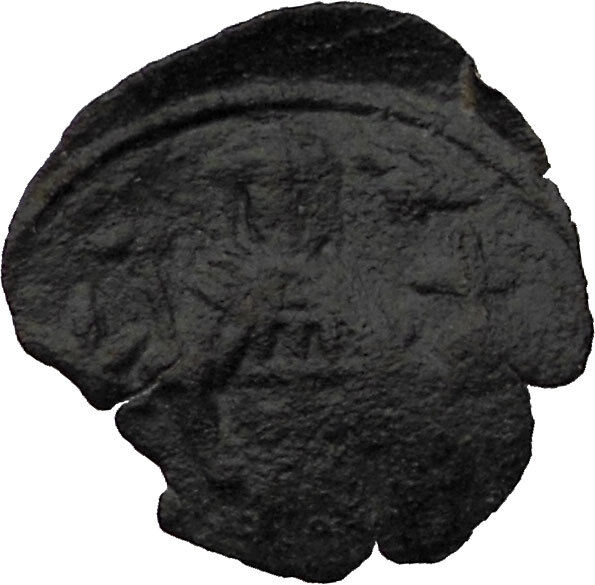|
Byzantine Empire
Constans II – Byzantine Emperor: September 641-15 July 668
A.D.
Bronze Follis 23mm (4.85 grams) Struck at Syracuse in Sicily
Reference: Sear 1103
InPЄR. COnSτ,. – Bust facing, beardless, wearing crown and chlamys, and holding
globe cross.
Large m between A / N / A and NЄΟs; in exergue, large SC, to left
of which is officina letter or cross.
You are bidding on the exact item pictured,
provided with a Certificate of Authenticity and Lifetime Guarantee of
Authenticity.
Constans II (Greek:
Κώνστας Β’, Kōnstas II), also called
“Constantine the Bearded” (Kōnstantinos Pogonatos), (November
7, 630
–September
15, 668
)
was
Byzantine emperor
from 641 to 668. He also was the last emperor to become
consul in 642,
becoming the last
Roman
consul
in history.
Constans is a diminutive nickname given to the emperor, who
had been baptized Herakleios and reigned officially as Constantine. The nickname
established itself in Byzantine texts, and has become standard in modern
historiography.
//
Biography
Constans was the son of
Constantine III
and
Gregoria
.
Due to the rumours that
Heraklonas
and Martina
had poisoned Constantine III he was named co-emperor in 641. Later that same
year his uncle was deposed and Constans II was left as sole emperor.
Constans owed his throne to a popular reaction against his
uncle and to the protection of the soldiers led by the general Valentinus.
Although the precocious emperor addressed the senate with a speech blaming
Heraklonas and Martina for eliminating his father, he reigned under a regency of
senators led by
Patriarch Paul II of Constantinople
. In 644 Valentinus attempted to seize
power for himself but failed.
Under Constans, the Byzantines completely withdrew from
Egypt
in 642, and
Caliph Uthman
launched numerous attacks on the islands of the
Mediterranean Sea
and
Aegean Sea
.
A Byzantine fleet under the admiral Manuel occupied
Alexandria
again in 645, but after a Muslim victory the following year this had to be
abandoned. The situation was complicated by the violent opposition to
Monothelitism
by the clergy in the west, and the related rebellion of the
Exarch of Carthage
, Gregory. The latter fell in battle against the army of Caliph
Uthman and the region remained a vassal state under
Caliphate
,
until the civil war broke out and the imperial rule was again restored.
Constans attempted to steer a middle line in the church
dispute between Orthodoxy and Monothelitism, by refusing to persecute either and
prohibiting further discussion of the natures of
Jesus
Christ
by
decree in 648. Naturally, this live-and-let-live compromise satisfied few
passionate participants in the dispute.
Meanwhile, the
Caliphate
advance continued unabated. In 647 they had entered into
Armenia
and
Cappadocia
,
and sacked
Caesarea Mazaca
. In 648 the Arabs raided into
Phrygia
and
in 649 launched their first maritime expedition against
Crete
. A major
Arab offensive into
Cilicia
and
Isauria
in
650–651 forced the emperor to enter into negotiations with
Caliph Uthman
‘s
governor of Syria
,
Muawiyah
.
The truce that followed allowed a short respite, and made it possible for
Constans to hold on to the western portions of Armenia.
In 654, however,
Muawiyah
renewed his raids by sea, and plundered
Rhodes
.
Constans led a fleet to attack the
Muslims
at Phoinike (off
Lycia
) in 655 at
the
Battle of the Masts
, but he was defeated: 500 Byzantine ships were destroyed
in the battle, and the emperor himself risked to be killed. Before the battle,
chronicler
Theophanes the Confessor
says, the emperor dreamt to be at Thessalonika,
this dream predicted his defeat against the Arabs because the word
Thessalonika
is similar to the sentence “thes allo niken”, that means “gave
victory to another (the enemy)”.[3]
Caliph Uthman
was preparing to attack
Constantinople
, but did not carry out the plan when civil war between the
future
Sunni
and
Shi’a
factions broke out among them in 656.
With the eastern frontier under less pressure, in 658
Constans defeated the
Slavs
in the Balkans
, temporarily reasserting some notion of Byzantine rule over them. In
659 he campaigned far to the east, taking advantage of a rebellion against the
Caliphate in Media
.
The same year he concluded peace with the Arabs.
Now Constans could turn to church matters once again.
Pope
Martin I
had condemned both Monothelitism and Constans’ attempt to halt
debates over it (the
Type of Constans
) in the
Lateran Council of 649
. Now the emperor ordered his Exarch of
Ravenna
to
arrest the Pope. One Exarch excused himself from this task, but his successor
carried it out in 653. The Pope was brought to Constantinople and condemned as a
criminal, ultimately being exiled to
Cherson
, where he died in 655.
Constans grew increasingly fearful that his younger brother,
Theodosius, could oust him from the throne: he therefore obliged him first to
take holy orders, and later had Theodosius killed in 660. Constans’ sons
Constantine, Heraclius, and Tiberius had been associated on the throne since the
650s. However, having attracted the hatred of citizens of Constantinople,
Constans decided to leave the capital and to move to
Syracuse
in Sicily
.
From here, in 661, he launched an assault against the
Lombard
Duchy of Benevento
, which then occupied most of
Southern Italy
. Taking advantage of the fact that Lombard king
Grimoald I of Benevento
was engaged against Frankish forces from
Neustria
,
Constans II disembarked at
Taranto
and
besieged Lucera
and Benevento
.
However, the latter resisted and Constans withdrew to
Naples
. During
the travel from Benevento to Naples, Constans II was defeated by Mitolas, Count
of Capua, near Pugna. Constans ordered Saburrus, the commander of his army, to
attack again the Lombards but he was defeated by the Beneventani at
Forino
, between
Avellino
and Salerno
.
In 663 Constans visited
Rome for 12 days—no
emperor having set foot in Rome for two centuries—and was received with great
honor by
Pope
Vitalian
(657–672). Although on friendly terms with Vitalian, he stripped
buildings, including the
Pantheon
, of their ornaments and bronze to be carried back to
Constantinople, and declared the
Pope of Rome
to have no jurisdiction over the Archbishop of Ravenna, since
that city was the seat of the
exarch
, his immediate representative.
His subsequent moves in
Calabria
and Sardinia
were marked by further strippings and request of tributes that enraged his
Italian subjects. Rumours that he was going to move the capital of the empire to
Syracuse were probably fatal for Constans. On
September 15
, 668
he was assassinated in his bath by his
chamberlain
. His son Constantine succeeded him as
Constantine IV
, a brief usurpation in Sicily by
Mezezius
being quickly suppressed by the new emperor.
Family
By his wife
Fausta
, a daughter of the patrician Valentinus, Constans II had three sons:
-
Constantine IV
, who succeeded as emperor
-
Heraclius, co-emperor from 659 to 681
-
Tiberius, co-emperor from 659 to 681
|








